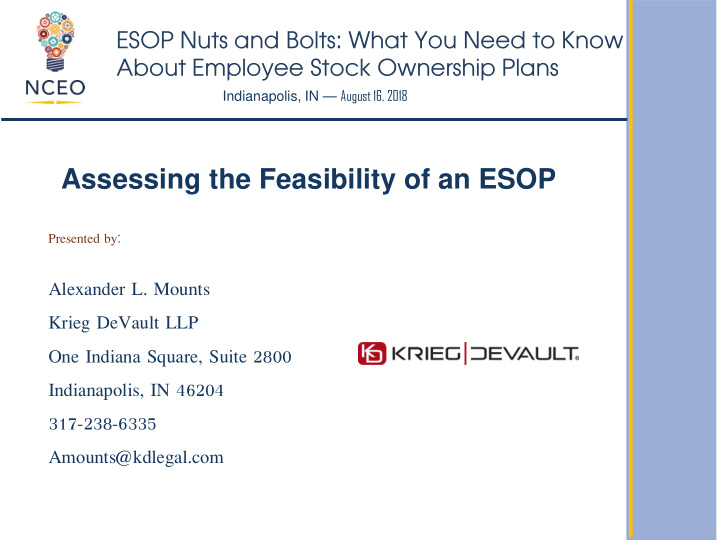



ESOP Nuts and Bolts: What You Need to Know About Employee Stock Ownership Plans Indianapolis, IN — August 16, 2018 Assessing the Feasibility of an ESOP Presented by: Alexander L. Mounts Krieg DeVault LLP One Indiana Square, Suite 2800 Indianapolis, IN 46204 317-238-6335 Amounts@kdlegal.com
Thinking about an ESOP? Goals & Objectives Shareholder Liquidity / Diversification • Can sell a portion or all equity to an ESOP • Tax benefits (1042 for seller) • Employee ownership culture • Sharing wealth creation capability • Employee Retirement plan • Alignment of financial interests between owner & • employees Continuing legacy of business • Strategic reasons • “Friendly”, “patient” shareholder • Other? 2
Good ESOP Candidates Closely held U.S. based company • Company can be a C-corp or an S-corp • At least 20 employees (companies with small • payroll bases may encounter problems under Code Sections 415 and 409(p) Profitable • Debt capacity • Stable earnings • Supportive management • 3
Good ESOP Candidates Identified ESOP objectives • Create and realize employee retirement benefits, cultural improvements, and operational efficiencies • Protect the shareholders’ legacy and Company heritage while realizing liquidity • Company desiring to utilize corporate tax savings to increase growth and accelerate debt repayment • Reward employees and management who helped build the Company 4
Business Considerations Strength of management team Capital constraints Culture 5
What is a Feasibility Analysis? Comprehensive review of the Company’s ownership structure, value and operating dynamics Addresses and incorporates shareholder objectives Can be part of a larger ownership transition analysis Might include multiple scenarios Provides a path to implementation of desired outcome 6
Why Conduct a Feasibility Analysis? Long-term look at the Company Determine whether a Company is a viable candidate for an ESOP Addresses different elements and potential hurdles of the transaction Analyze different transaction structures to determine the best result 7
Why Conduct a Feasibility Analysis? Current ownership characteristics • Family business lacking a “next generation,” and/or looking to realize liquidity prior to transitioning management to family or non-family management • “Diffuse” ownership group looking to consolidate control and align interest in growing the Company • “Segmented” professionals looking for a tax efficient means of delivering employee ownership similar to a partnership 8
Shareholder Expectations Valuation expectations • ESOPs cannot pay more than fair market value • Is the valuation expectation - • Realistic given current M&A market dynamics • Supported by past Company performance? • Based on defendable Company projections? • Reflective of broader industry trends? 9
Shareholder Expectations Liquidity requirements • Most ESOP transactions require the seller to receive a note (the “seller note”) as partial payment for their stock • Sources of payment: cash vs. seller note • Seller Notes • Determine total return through note structure (term of note, cash interest, warrants, etc.) • Seller can be a more “flexible” creditor than traditional lenders 10
Shareholder Expectations Post-closing governance Involvement in the business post transaction • “Control” at the Board of Directors Level • “Control” at the Management Level Preservation of the: • Shareholders’ legacy • Company/Community jobs • Presence/Status in the geographic or industry community 11
Conflicts of Interest Company providers • Historically an “Exploratory Committee” reviewed the possibility of an ESOP transaction • The Trustee will not use a valuation advisor for a transaction that has previously performed work – including but not limited to a “preliminary valuation” – for or on behalf of the ESOP sponsor 12
Conflicts of Interest Who are the Sellers? Who is the Trustee? Participation in the business vs. absentee owners Development of projections/financials on which the valuation is based • Historical financials • Quality of Earning’s Analysis • Basis for projections 13
Valuation Considerations/Evaluations Review of projections/determining reasonableness of projections • Comparison to historical results • Comparison to comparable companies’ historical results • Industry review and evaluation of projected company vs. market growth • Impact of recession on historical results and implied potential impact on projections • Accounting for anticipated capital expenditures, both cash outlay and anticipate return on investment • Use of cash and impact on the Company’s working capital 14
Preparing for a Transaction Contemplating transaction structure/identifying drivers Understanding risks and rewards of various transaction structures 15
Preparing for a Transaction Clean up financials Understand other opportunities • Impact of other valuations/letter of intent • Exploring third party buyers prior to/coincident with ESOP transaction Organize company records Legal clean up • Legal diligence and how to prepare Begin conversations with existing banking relationships to determine level of interest 16
Build/Secure the Management Team Management evaluation • Sellers need to evaluate management teams and succession plans Tools to drive performance • Long Term Incentive Plans (LTIP) • ESOP communications 17
Impact of Personal Planning Decisions Inform advisors of long term plans and goals so that they can be incorporated into the transaction strategy 18
Questions ? Alexander L. Mounts Krieg DeVault LLP One Indiana Square, Suite 2800 Indianapolis, IN 46204 317-238-6335 Amounts@kdlegal.com 19
Recommend
More recommend